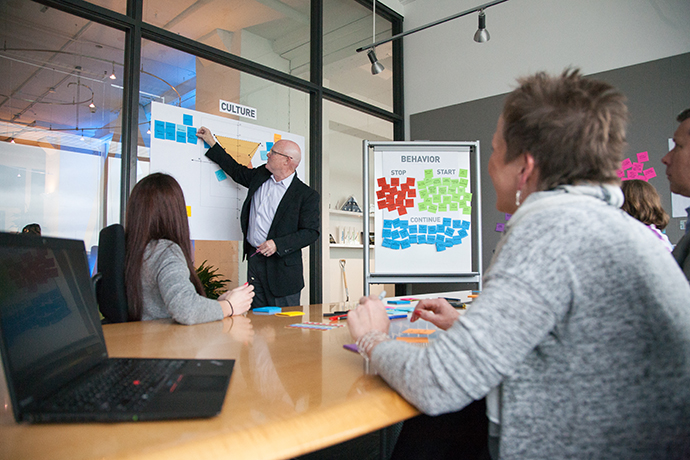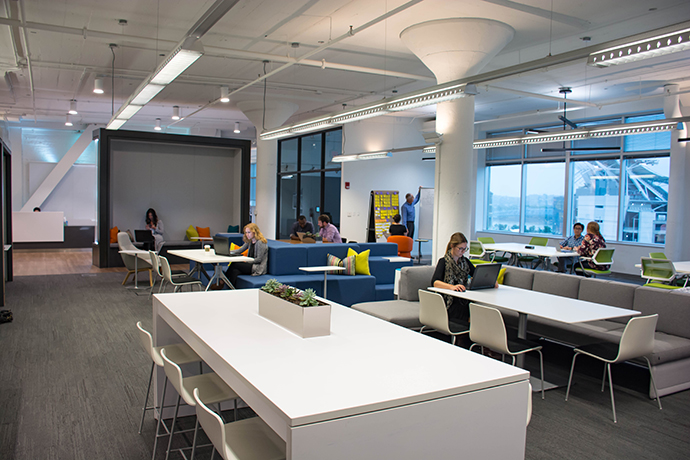This is the first in a bimonthly series of six articles on the growth, value, and future of design for people. The intent is to explore and discover the impact of behavior, habits, and patterns of people in the design of environments.

There is no doubt whatever about the influence of architecture and structure upon human character and action. We make our buildings and afterwards they make us. They regulate the course of our lives. -Winston Churchill, 1924
To design an environment is to know what will likely occur in that environment. The more capably a designer is able to get in touch with the intended purpose of the space, the more likely the designer’s final plan will create value for its tenants. Knowing the actions and attitudes that will inhabit a structure means going beyond the standard designations that usually apply. For example, designing an office space for a marketing team is not the same as creating one for a law firm. The specifics and the nuances are better revealed when the design looks past workplace form and function and zeros in on the actions and attitudes of the people who will work there.
Why design for behavior
Design has been analyzed from many vantage points. There seems to be a general consensus among industry experts that the structure of a building and its interior play a big role influencing behavior. Others believe attitudinal change precedes behavioral change. Either way, the conversation about designing for behavior is happening and open for discussion. Think about it. The lives of countless people play out inside buildings. The majority of thoughts people have occur there, and it is where their daily emotions unfold. Each of those activities comprises behaviors for which design can and should play a role.
There’s no question that design affects the brain. Different adaptations might include creating spaces that are green, encourage activity, or even promote social interaction. There are numerous frameworks that will arise in the world of design. For instance, with growing urbanization in United States’ cities, it is becoming more significant and preferable to work in a structure that was built with an emphasis on mental and physical health. As time goes on, there will be greater potential for this type of adaptive design.
Connectivity between action and attitude
One way to understand designing for behavior is by first answering the question, “What is a behavior?” A summary of the definition follows: “Human behavior is a function of the actions and attitudes of people within an environment.” Then, break that down further:
- An action is “a sensory and cognitive process that is measurable and observable.”
- An attitude is an “emotive and intuitive response that requires relationship and story.”
By looking directly at the actions and attitudes of people, a correlation can be drawn. For example, imagine a workplace with no doors. No conference rooms doors, no office doors, no storage closet doors, nor bathroom doors. From this dramatic point-of-view, the nature of a door drives behavior. Doors mean instant privacy, necessary confidentiality, solitude for focus, as well as for designation and status. Asking questions about built elements, like doors, allows designers to probe into just exactly who someone is. By gaining a feel for people’s attitudes, design can anticipate what actions will be taken as a result of those attitudes. For example, if a company is evolving toward flatter operation systems, doors assigned to individuals based on their status may drive the wrong behaviors in the future.
Additional attitudinal questions might include, “What do you accomplish in a given day?” “What do you look forward to most about your job?” or “What is it about your work that excites you?” Not surprisingly, the answers may be more tangible to design than those that come from asking questions like, “Which behaviors do you need from your people to generate better results?” What evolves from focusing more on attitudes and actions can be studied using a formula: Human Behavior = f (Action x Attitude) Environment—or “Human behavior is a function of the actions and attitudes of people within an environment.”
The “Environment” variable can then materialize through the design thinking process. Since one of the tasks of design is to create human environments, then one responsibility of the designer is to guide compassion, imagination, and mental power—all while making evident the relationship between physical parameters and the human response.

Gathering the data
Until now, relatively few studies have been conducted on the psychological implications of architecture. However, recently there’s been an upsurge of interest to determine if there is an ideal architectural structure for different types of thinking, or if one form of space influences behavior differently than another.
One experiment, conducted by Joan Meyers-Levy, professor emeritus in marketing from the University of Minnesota’s Carlson School of Management, examined the relationship between ceiling height and thinking style. Levy learned some interesting facts. Low-ceiling rooms favored those whose need was to focus on the details of a subject or object. By contrast, lofty ceilings were conducive to abstract styles of thinking, brainstorming, creative solutions, and zooming out to see the panoramic perspective. Experiments like this say a lot about the effects of environment, and research on the subject is still in its infancy. The good news is that it seems to be a universally accepted notion that architecture has actual cognitive consequences that need to be exposed.
Some of the bonds that have been forged to study designing for behavior are certain to reveal significant outcomes. For instance, a research group of neuroscientists and psychologists has teamed up with group of architects and designers to examine the way spaces have psychological impact on inhabitants and why it’s vital to study them. The more the results of these studies continue to confirm the significant degree to which design affects the brain, the more the industry can count on the development of new design tools and methods that will be conducive to changing the built world that is the environment.
Industry support
Multiple associations and organizations are being established in an effort to improve the way buildings are inhabited. For example, Itai Palti, Director of Architecture and Design at Bartlett School of Architecture’s Centric Lab in London, used the science of developmental psychology to inform the design of Urban Thinkscape, a set of playful learning installations focused on language and math that can be placed among urban settings families are likely to encounter. Palti has recently teamed up with Bar-Ilan University neuroscientist Dr. Moshe Bar, to examine “conscious cities,” which Palti founded. These are built environments that apply the findings of behavioral and cognitive sciences to more actively respond to their users.
Another example comes from Colin Ellard, who is an expert in the movement of people. For more than 10 years he has studied how people make their way to places and how different types of environments impact their brains. Ellard is a professor of cognitive neuroscience at the University of Waterloo in Ontario, Canada, where he serves as director of the Urban Realities Laboratory where he studies the impact of urban design on human psychology. The laboratory uses a wide variety of methods ranging from field studies of behavior in urban and architectural settings to the use of immersive virtual reality to test predictions about urban behavior in simulations. For instance, the lab analyzed responses to common cityscapes such as heavily traveled intersections, hiking paths, and downtown layout. From this data, they were equipped to draw conclusions about what causes a person’s fear and anxiety in an urban setting.
Another organization studying human response to architecture and design is ANFA, the Academy of Neuroscience for Architecture. ANFA’s mission is to promote and advance knowledge that links neuroscience research to a growing understanding of human responses to the built environment. It is the only organization in the world devoted to the goal of building intellectual bridges between neuroscience and architecture.
As design evolves
It’s interesting to watch the evolution of design as it relates to workplace behavior. There are more mature management systems, higher degrees of agility and flexibility, and stronger emphasis on innovation grown from collaboration. As work transforms to meet this progress, the demands on the workplace will evolve to accommodate renewed behavioral actions and attitudes. Each variable plays an important role in bringing the industry to its current way of thinking. What can be gained by focusing on workplace behaviors, reflected in people’s attitudes and actions, will become an increasingly vital part of a designer’s planning process.


